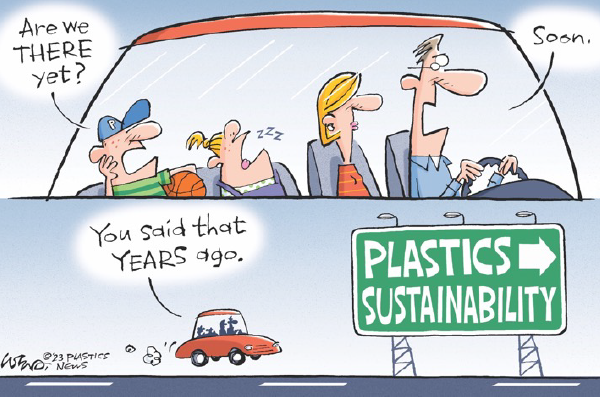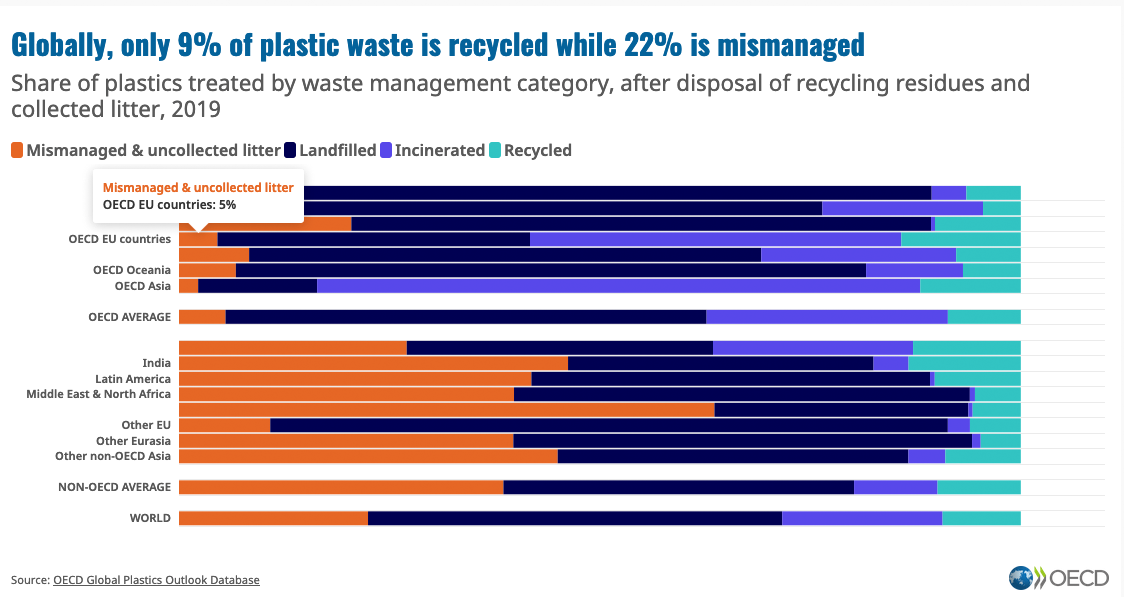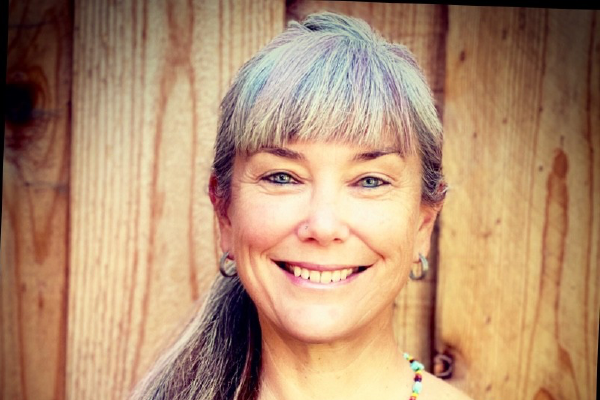| |
|
|
| |
|
|
| |
The Transition | April 2023
People and progress in solving the ocean plastic crisis
About OpenOceans Global. Our work centers on mapping ocean plastic, curating the best solutions, and linking together a community of ocean plastic experts and leaders. Learn more on NBC7/39's Down to Earth segment and Esri's ArcNews.
Past issues of The Transition.
Correction. In the March 2023 issue of The Transition, the biographies of David Katz, the founder of Plastic Bank, and Romell Nandi, the Trash Free Waters National Program Lead for the U.S. Environmental Protection Agency, were preliminary drafts, not the final approved language. That language was corrected and can be seen in the updated version of the March issue. We apologize.
|
|
|
|
| |
|
|
| |
|
Did you know?
Virtually every piece of plastic that was ever made since 1907 still exists in some shape or form (except the small amount that has been incinerated)
|
|
|
|
| |
|
|
| |
Taking a Deeper Dive
Progress on ocean plastic is slow, but some solutions are gaining ground
 Image credit: Plastics News/Rich Williams Image credit: Plastics News/Rich Williams
A brief history of the rise of ocean plastic
Understanding the evolution of the ocean plastic crisis is important to understand where we stand today and how the evolution to a plastic-free ocean might unfold. OpenOceans Global checked resources from the Science History Institute, along with information from the United Nations Environment Programme (UNEP) to assemble some background on the history. Here are some key facts:
- The first synthetic polymer was invented in 1869 in response to a $100,000 challenge to anyone who could create a substitute for ivory, replacing the need to kill wild elephants to create products like pool balls.
- In 1907, the first synthetic plastic was created, in the form of Bakelite, first used as an insulating material. It was “durable, heat-resistant, and ideally suited for mechanical mass production.”It could be “shaped or molded into almost anything.”
- During World War II, plastic use grew by 300% to make products that otherwise would need to be made from scarce natural resources.
- Following the war, plastic began to take the place of traditional materials, including steel in cars, paper and glass in packaging, and wood in furniture.
- Plastic was seen as an inexpensive, safe, sanitary substance that could be shaped by humans to their every whim.
- Plastic debris was first observed in the oceans in the 1960s.
- In the 1970s and 1980s, anxiety about waste increased, and the plastics industry led an influential drive encouraging municipalities to collect and process recyclable materials as part of their waste management systems.
- Between the 1970s and the 1990s, plastic waste generation more than tripled, reflecting a similar rise in plastic production.
- In the early 2000s, the amount of plastic waste generated rose more in a single decade than it had in the previous 40 years.
A high-level take on the status of the ocean plastic crisis
Where does that leave us - a world with a seemingly insatiable demand for the convenience and low cost of plastic and a demonstrated lack of success in replacing, reusing, recycling, and managing plastic waste?

Image credit: OECD Global Plastic Outlook Database
As you can see from the chart above from the Organization for Economic Co-operation and Development (OECD), there are only three ways to dispose of plastic waste: put it in a landfill, incinerate it, or recycle or reuse it. The rest is mismanaged and uncollected litter, often trashing the world’s environment both on land and at sea. Here’s a high-level take on where we are today.
The Bad
Despite efforts to address plastic waste going back at least 40 years, it is still a growing crisis. Some factoids:
- Plastic waste has dramatically increased. The UN says 400 million metric tons of plastic waste are produced every year, and the Pew Charitable Trusts estimates that plastic will increase from 11 million metric tons annually in 2020 to 29 MT in 2040.
- Waste management is still lacking globally. According to Visual Capitalist, India, China, and the Philippines lead the world in the most mismanaged plastic waste, with the Philippines alone accounting for 350,000 tons, or 37%, of mismanaged waste released into the ocean annually.
- Recycling success is limited. Despite more than 40 years of messaging, only 9% of all plastic produced has been recycled, and 22% of plastic is mismanaged, according to the OECD.
The Good
Here are some examples of where progress is being made.
- International Plastic Treaty is a UN priority. The United Nations Environment Assembly in March 2022 made it a priority to end plastic pollution and forge an international legally binding agreement by 2024 addressing the full lifecycle of plastic from source to sea.
- Solutions are emerging. All around the world, sometimes in the most unexpected places, entrepreneurs are working on solutions to expand the ability to collect, reuse, recycle, replace, and even transform plastic. We feature some of the people and the solutions each month in this newsletter, and more solutions are on our website.
- River interception is gaining ground. Since most plastic reaches the ocean from rivers, it is encouraging to see technologies and processes emerging to capture the plastic before it reaches the ocean. Two notable efforts are the Sungai Watch in Indonesia which is currently cleaning 100 rivers and The Ocean Cleanup’s River Interceptor which is being tested in multiple locations around the globe.
- PET plastic is highly recyclable. The most successful recycling effort has been achieved through polyethylene terephthalate (PET) plastic which, according to the International Bottled Water Association, is 100 % recyclable and is the most recycled plastic in the worldwide. It is primarily reused (or used as feedstock) for plastic bottles and food containers. Norway and India, most notably, have met or exceeded recycling 90% of PET plastic. According to a paper published by the National Center for Biotechnology Information (NCBI), PET packaging accounted for 44.7% of single-serve beverage packaging in the US in 2021, and 12% of global solid waste.
- Mismanaged waste in the U.S. and the EU. Even though the U.S. and the European Union are leaders in producing plastic waste, relatively little is mismanaged, according to the OECD. The chart below shows comparisons from around the world.
 Image credit: UN Council on Foreign Relations/OECD Image credit: UN Council on Foreign Relations/OECD
Still Trying
A number of efforts to address ocean plastic are aspirational and haven’t met the goals desired, others are in progress but not ready for prime time, and some are controversial.
- Plastic campaigns. According to the U.N. Council on Foreign Relations, initiatives like the UNEP’s Clean Seas Campaign and the 2020 World Trade Organization (WTO) initiative to promote a circular economy for plastics have had limited impact on plastic waste.
- Recycling Goals. According to Plastics News, in 2018, resin supplier members of the American Chemistry Council announced a goal of "reusing, recycling or recovering all plastics packaging by 2040.” The following year, the Ellen MacArthur Foundation accelerated the timeline with a goal for retailers to increase recycled content in their packaging to 25% by 2025. The global average at that time was 2%. The year after that, the U.S. Plastics Pact set a goal for recycling or composting 50% of plastic packaging by 2025 and using 30% recycled or bio-based content in plastics packaging. Plastics News writes “we aren't anywhere close to achieving these goals.”
- Bioplastics and biodegradable plastics are being explored. Bioplastics, made from plant crops instead of fossil fuels, are thought to be more environmentally friendly than conventional plastics. However, some bioplastics also take a long time to degrade in the environment. According to an opinion in PHYS.ORG, “bioplastics aren't ready for prime time … we don't have widely available pathways to compost or process them at the end of their lives. Nearly always, they end up in a landfill.”
- Chemical recycling. As reported by the National Caucus of Environmental Legislators, the European Union defines chemical recycling as “when plastics are converted into liquids or gas through pyrolysis, gasification, or other methods of heating, and then are recycled into new plastics.” A number of technologies are being developed, according to Chemical Recycling Europe, concluding “it is not a recycling solution which has been fully scaled yet.” In addition, “The EU notes that plastic-to-plastic chemical recycling is extremely energy-intensive, costly, and ultimately, does not stop plastic pollution at its source."
- Aligning regulations across state and national boundaries. Challenges to improving the circularity of plastic often involve different regulations to address manufacturing, disposal, and recycling. In comments by the Australian Packaging Covenant Organization (APCO) to the United Nations regarding proposed objectives for the international plastic treaty, APCO wrote this: “Define clear global guidelines on the responsibility for plastic packaging, including design, distribution and responsible end-of-life management to reduce packaging impact on human life, environment, particularly marine environment, and national economies. The instrument outlines mandatory and voluntary approaches to address different country’s capacities, economic abilities, and environmental urgencies.”
More to know and more to do – together
There is much more to report than summarized above, and OpenOceans Global hopes this information will encourage additional thinking in understanding the real status of the ocean plastic crisis and efforts to address this environmental disaster. Working together, from a factual foundation, we can make a difference.
|
|
|
|
| |
|
|
| |
Tracking Plastic News
 Image credit: Wizard of Id/Mick Mastroianni Image credit: Wizard of Id/Mick Mastroianni
- WEBINAR - Greenwashing: Debunking the Plastic Industry’s False Narrative, Plastic Solution Coalition, April 19, 2023, 5:00 p.m. – 6:00 p.m. EDT
- Senate hearings seek ‘national strategies' on plastics, Plastic News, April 5, 2023
- Americans say recycling is too hard and doesn’t make any difference, Reputation Leaders, April 2023
- Microplastic found in Antarctic krill and salps, PHYS.ORG, March 29, 2023
- Plastics Are Devastating the Guts of Seabirds, Wired, March 27, 2023
- Ad panels say ABA overstated PET bottle recycling efforts, Plastic News, March 21, 2023
- Testing at the Source: California Readies a Groundbreaking Hunt to Check for Microplastics in Drinking Water, Western Water, March 17, 2023
- Plastics in the battle for 'hearts and minds' of consumers, Plastic News, March 3, 2023
|
|
|
|
| |
|
|
| |
Mapping Plastic-Fouled Coastlines
See more beaches fouled by plastic on our ocean plastic trash map. To report a shoreline pervasively fouled by significant amounts of plastic debris, use our online plastic trash reporting app.
This Month's Coastal Hotspot: Aldabra Atoll, Seychelles
 Image credit: Blue Marine Foundation Image credit: Blue Marine Foundation
Aldabra Atoll is a remote UNESCO World Heritage site sandwiched between two major current systems in the southwest Indian Ocean. Unfortunately, the atoll has become known for being covered with trash. According to the Blue Marine Foundation, Aldabra Atoll has one of the highest densities of accumulated marine plastic litter worldwide. The converging ocean currents bring in “plastic waste, mainly from industrial fishing. Hundreds of tons of nets, ropes, and lost or discarded hi-tech fish aggregating devices (FADs) end up wedged in mangroves, tangled in coral reefs, and washed up on beaches.” Researchers from the University of Oxford co-lead the Aldabra Clean Up project and research the impact of marine pollution, particularly FADs, in the Seychelles. In 2019, a large-scale cleanup collected and removed 25 tons of waste from Aldabra’s coastline, an amount estimated to be just 5% of the annual waste problem. Researchers estimated that more than 500 tons of waste has accumulated on Aldabra Atoll alone, and more is arriving all the time.
|
|
|
|
| |
|
|
| |
Solutions to the Ocean Plastic Crisis
See more solutions on our ocean plastic solutions page. Have a solution we should know about? Submit it here.
This Month’s Featured Solution: Washed Ashore
 Image credit: Washed Ashore Image credit: Washed Ashore
Public awareness of the ocean plastic crisis is critical to solving it. The Washed Ashore Project creates powerful art that captivates all ages and teaches environmental conservation and sustainability. The project creates intricate, beautifully designed, giant sealife sculptures made entirely of marine debris collected from beaches. The sculptures of marine life graphically illustrate the tragedy of plastic pollution in our oceans and waterways to encourage conservation. The project was created by the nonprofit Artula Institute for Arts and Education. Initially, Artula hosted an Artist in Residency program by the sea in Bandon, Oregon. Washed Ashore’s continued growth has become the cornerstone of Artula, with four traveling exhibits, ongoing sculpture-making and a multitude of other projects. The traveling exhibits include workshops led by the project’s expert education team combining art, science, and environmental issues.
|
|
|
|
| |
|
|
| |
Meet the Experts and Leaders
OpenOceans Global is identifying ocean plastic experts from around the world. Here are two experts leading efforts to reduce plastic pollution that you should know about.
Laurent Lebreton, Head of Research, The Ocean Cleanup
 Image credit: Laurent Lebreton Image credit: Laurent Lebreton
Laurent Lebreton is the head of research at The Ocean Cleanup, a not-for-profit organization that develops technology to rid the ocean of plastic. His research group focuses on understanding the sources of ocean plastics, their transport, and their ultimate fate by leading large-scale field expeditions, developing advanced numerical models, and investing in remote sensing technology. Ultimately, Lebreton is interested in closing a global mass balance budget for plastics in our oceans as a direct tool for the rapid implementation of a wide range of mitigation strategies from local to global scale. Lebreton started his research on ocean plastics in 2010 when he tried to predict the formation of ocean garbage patches using numerical models on his computer at his home office in Raglan, Waikato, New Zealand. He has been involved in many groups working in the field of marine litter, including GESAMP, a group of independent scientific experts that provides advice to the UN system on scientific aspects of marine environmental protection, and other working groups funded by the United Nations Environment Program. Important publications include: More than 1000 rivers account for 80% of global riverine plastic emissions into the ocean and Industrialised fishing nations largely contribute to floating plastic pollution in the North Pacific subtropical gyre.
Nicky Davies, Executive Director, Plastic Solutions Fund
 Image credit: Plastic Solutions Fund Image credit: Plastic Solutions Fund
Nicola (Nicky) Davies is the executive director of the Plastic Solutions Fund (PSF), an international funder collaborative dedicated to tackling the crisis of plastic pollution, which impacts the health of people and ecosystems all over the planet. PSF supports projects to reduce the production of single-use plastic and packaging, focusing on system transformation. The work supports a global multilayered NGO strategy to change (1) the behavior of companies that are major plastics producers and users, (2) how cities deal with waste, and 3) how people interact with plastics. It also focuses on building a reuse economy to transition away from single-use plastic. In 2016, with funding from the Oak and Marisla foundations, Davies worked with more than 50 NGOs from around the world to create a global plastic pollution strategy. The global movement known as Break Free From Plastic grew out of this process. The initial funders committed to securing more funds to form a longer-term entity which became the Plastic Solutions Fund in 2017. The Fund now has 22 participating foundations and has provided more than $50,000,000 to 130 civil society organizations around the world. Davies has nearly 20 years of experience in leading systems change in the environment and social change sector. Her personal mission is to create a better world for future generations that is more equitable for all. Davies previously served as a program director at Greenpeace USA, the deputy director for climate and energy at Greenpeace International, and the executive director of the Conservation Council ACT Region in Canberra, Australia.
|
|
|
|
| |
|
|
| |
|
|
| |
|
|
| |
|
|
| |
|
|
| |
|
|
| |
|
|
| |
|
|
|